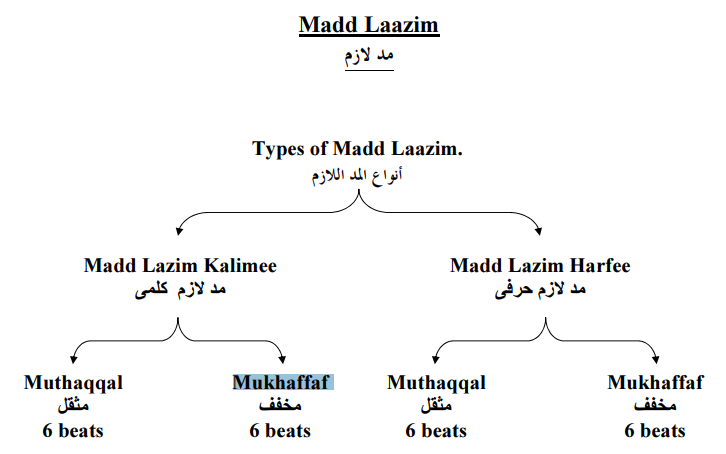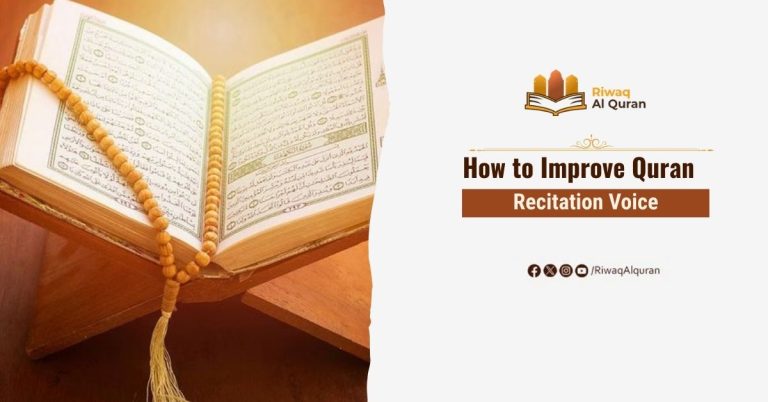There is no doubt that mastering the Mudood (elongations) while reciting the Qur’an keeps that meant, special, rhythmic tone, which captivates the heart, and touches the soul. That, in turn, creates such a spiritual connection with the Qur’an, which is the aim of learning tajweed ultimately.
Madd Lazim is one of the Madd types to apply while reciting Qur’an. It is essential for the Qur’an-reciter to be attentive to its definition, significance, and subtypes, so that he can spot the due cases to elongate. Let’s know together about Madd Lazim.
Table of Contents
The Definition of Madd Lazim:
So simply, Madd in Arabic means (elongation), and Lazim in Arabic means (necessary). So, Madd Lazim is that necessary elongation applied to certain letters in certain words during recitation.
Madd Lazim is due to apply when there is a static consonant/sound coming after a letter, or sound of elongation (Alif ا, waw و, Yaa ي) within a single word, or letter. The duration of applying this Madd is six counts.
Why Learning Madd Lazim?
As we know, every single sound and letter in the Qur’an has a part to do with the depth, meaning, and harmony of Allah’s message. Therefore, applying Madd Lazim is significant, as it:
1. Betters the Qur’an-Recitation:
As Madd Lazim is one of the tajweed rules, so it is a given that properly applying it will definitely better our recitation of the Qur’an, aiming at following the ideal, Prophet’s recitation which was known by its deliberate rhythm, and elongated tone, maintaining all the mudood.
2. Highlights the Clarity, Emphasis, Meaningfulness of the Qur’an:
For sure, elongation of certain letters makes us take more seconds to contemplate that clear emphasis on those certain words, aiming at more understanding of Allah’s Message revealed to us.
Moreover, Madd Lazim is not just a melodious option, but rather a phonetic necessity to preserve the intended meanings of the Qur’an, without messing up.
3. Accentuates the Beautiful Melodic Rhythm:
Applying the Madd Lazim while reciting prominently accentuates such beautiful, melodic pattern of the Qur’an that is so appealing to the ears, and fascinating to the hearts.
4. Deepens the Spiritual Connection to Allah’s Words:
Certainly, genuinely feeling and understanding Allah’s message to us, through a rightly balanced, toned, and smooth flow of the recitation deepens our connection and strengthens our bond with the Qur’an.


Madd Lazim Chart:
This is a simplified chart, to keep in mind, of the types of the Madd Lazim that we are going to explain:

Madd Lazim Types and Examples:
Madd Lazim is divided into two types: Kalamee (Word-based), and Harfee (Letter-based), which are, themselves, divided into two subtypes: Mukhaffaf (light), and Muthaqqal (heavy).
As a Result, we get those 4 types (2 for Madd Lazim Kalamee and 2 for Madd Harfee):
1. Madd Lazim Kalimee Muthaqqal (Heavy, Word-Based, Necessary Elongation):
Madd Lazim Kalimee Muthaqqal occurs when a Madd-letter is followed by a consonant letter with shaddah in the same word. Then, the reciter needs to elongate the Madd letter for six counts.
Here, we call this Madd Muthaqqal because of the heavy sound caused by the shaddah on the following letter.
Example: الحآقًة /Al haaaaaaqqah/- الصآخًة /Assaaaaaakhah/.
2. Madd Lazim Kalimee Mukhaffaf (Light, Word-Based, Necessary Elongation):
Madd Lazim Kalimee Mukhaffaf occurs when a Madd-Letter is followed by a static consonant (with sukoon), in the same word, without shaddah. Then, the reciter needs to elongate the Madd Letter for six counts.
We call this Madd Mukhaffaf because of the light sound, without a shaddah on the following letter.
Example: ءآلئن /Aaaaaal’ana/.
3. Madd Lazim Harfee Muthaqqal (Heavy, Letter-Based, Necessary Elongation):
Madd Lazim Harfee Muthaqqal occurs in any letter of those pronounced as three letters with the center letter being a letter of Madd, and followed by a sound emphasized and merging into the next, that is why it produces a heavy sound, and called ‘Muthaqqal”.
Those letters are gathered in the Arabic statement. (نقص عسلكم), from the 14 disjointed letters revealed at the beginnings of some surahs in the Qur’an.
Madd Lazim Harfee Muthaqqal takes six counts in those letters (س، ن، ق، ص، ع، ل، ك، م). Their pronunciation are spelled out in three letters, such as pronouncing ل /lam/ is spelled in three letters in Arabic as لام , while ا is the middle sound as a Madd letter, and so are the other letters (، ع، ن، ق، ص، س، ك، م).
Example: طسم /ttaa Seeeeeen Meeeeeem/, ألم /Alif laaaaaam meeeeeem/
The last, sakin pronouncing sound of س، ل– which are /n/, and /m/– merges heavily with the first sound /m/ of the next letter, م. This is Madd Lazim Harfee Muthaqqal.
4. Madd Lazim Harfee Mukhaffaf (Light, Letter-Based, Necessary Elongation):
Madd Lazim Harfi Mukhaffaf occurs when there is a Madd sound in the letter followed by a Sukoon, without merging, nor emphasizing; that can be found at the beginning of surahs.
Example: ق /Qaaaaaaf/, ألر /Alif laaaaaam raaaaaa’/
Here, there is no merging happening; so the sound is smooth and light; that is why it is called “Mukhaffaf”; Madd Lazim Harfee Mukhaffaf takes six counts to apply.
Exceptions for Madd Lazim:
Mainly, Madd Lazim is that necessary elongation, due for six counts. Therefore, there are other exceptional letters of those disjointed ones at the beginnings of some surahs which are different, regarding the duration of Madd-elongation. Have a look at this:
| Category | Description | Examples |
| No Extra Madd | Only for the letter alif (أ) | |
| Madd of Two Counts | Letters pronounced as two letters with the second being a letter of Madd (ح ي ط ه ر)Pronounced as (حا يا طا ها را) | (حي طهر) |
| Madd for Four or Six Counts | Only for the letter ‘ain (ع) |
Read more about: Al-Madd Al-Aarid Lilssukoon
How to Learn the Rules of Madd Lazim?
As said, Madd Lazim is necessary to understand and apply while reciting the Qur’an. So, here are some advice for you to keep the track of the Madd rules:
Focus on Understanding the Basic Rules:
Don’t rush to know all the types, examples, and advanced details of the Madd, before understanding its basics, like definition, how to actually pronounce it while reciting, its distinguishing features, and so on. Try to grasp the rule, step by step, so that you can apply it clearly and properly.
Get Revised and Corrected by Specialized Teachers:
You can get confused by the tajweed rules, at some point. So, you need to seek the help of specialized, well-versed teachers, like those in Riwaq Academy, to help you precisely understand each piece of information you gain, and correct the recitation mistakes that you can inattentively make.
Keep Practicing:
As known, we all are commanded to apply tajweed properly, to follow the Prophetic recitation of Qur’an. Practicing Madd then is a necessity, that will accelerate your learning process and make you a proficient reciter.
Make Use of The Clarifying Charts:
The rules of tajweed may seem complex and branched out, like the madd, and its types and exceptions, so charts and diagrams will be great for you to see the whole picture clear.
Take Online Tajweed Quizes:
Taking online tajweed texts will help you to keep attentive, learning the Madd rules by heart, and to gain confidence while reciting the Qur’an perfectly.


Learn Quran, Arabic And Islamic Studies Online With The Best Native Tutors
Riwaq Al Quran is a comprehensive online platform that offers personalized Quran, Arabic and Islamic Studies Online classes for individuals of all ages and backgrounds.
Their experienced instructors use a structured curriculum to cover Tajweed, Tafsir, and Memorization, providing easy and effective access to learning the Quran.
The advanced online classes allow for seamless communication and interaction between students and teachers. Join Riwaq Al Quran for a deeper connection with the Quran.
We offer several courses such as:
- Online courses for kids.
- Online Quran classes for kids and adults.
- Online Arabic courses
- Online Ijazah courses
- Online Islamic Studies courses.
Here are a sample of our set of Quran Courses that will be helpful for you:
- Online Tafseer Course: Delve into Quranic meanings with our insightful online Tafseer course.
- Noorani Qaida Online: Learn Quranic basics efficiently through our Noorani Qaida online program.
- Online Quran Recitation Course: Enhance Quranic recitation skills through our expert-led online course.
- Online Tajweed Classes: Master Tajweed rules for beautiful Quranic recitation in online classes.
- Quran Memorization Online Course: Memorize the Quran effectively with our specialized online memorization course.
- Online Qirat Course: Explore diverse Qirat styles with our comprehensive online Qirat course.
Online Quran Classes for Kids: Nurture a love for the Quran in kids through interactive online classes.
Conclusion:
Madd Lazim is necessary elongation that you need to learn and apply while reciting Qur’an, for keeping the subtle, harmonious rhythm and meanings of this Holy Book. Pay attention to the Madd lazim rules, and advisably, ask for the guidelines and instructions of trusted, highly-qualified teachers, like in Riwaq Academy, to be sure of the proficiency of your learning process.


































